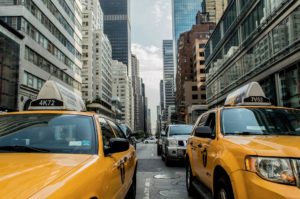
Imagine pressing a button and, within minutes, a personal chauffeur arrives at your front door. Uber, the popular ridesharing app, has made this a common occurrence in over 300 cities spanning 58 countries worldwide. Users need only open the app on their smartphone, set their desired destination, press “Request Uber,” and a driver will arrive in minutes. No physical money changes hands, as the user’s credit card is billed automatically with tip figured in. In the words of Uber co-founder, Garrett Camp, “everyone can ride like a millionaire.”
Since its inception in 2009, Uber has exploded into a transportation juggernaut valued at over $50 billion, but not without a fight. When establishing its network in a new city, Uber consistently faces staunch opposition from governments and taxi lobbies, which argue that Uber should not be able to skirt typical transportation regulations by hiding behind the façade that it is a mere smartphone app. Other than the clear competitive threat, much of this opposition is focused on the less-than-perfect insurance coverage provided by Uber.
Uber holds itself out to be nothing more than a “transportation network company” with a ridesharing app that connects its users with drivers. The company is eager to clarify that its drivers are not Uber employees nor do they function within the scope of any employment with Uber, but rather its drivers are classified as independent contractors. Uber drivers are required to have their own personal auto insurance. Uber provides its drivers with $1 million of commercial liability insurance coverage from the moment a user’s Uber request is accepted to the time the user is dropped off. The period when the driver has logged into the Uber network and is “available” but has not accepted a ride request is the “insurance gap” that has been subject to intense scrutiny. During this period, Uber has claimed that its drivers, as independent contractors, are not working under the control of Uber, and therefore, it is not liable for any accidents. This assertion has been challenged in a wrongful death case in San Francisco Superior Court in which an Uber driver struck a woman while he was “available” but had not accepted a ride request. In response to this case and effective as of March 14, 2014, Uber will now provide coverage (50k/100k/25k limits) when the driver is “available” and has not accepted a user’s Uber request only if the driver’s personal insurance “completely declines or pays zero.”
The tension is between Uber, which wants to avoid liability, and the driver’s personal insurance provider, which ordinarily will not cover a vehicle being operated for commercial purposes. In fact, there are cases of insurance companies cancelling personal auto insurance policies upon realizing that the insured drives for a ridesharing service. If both Uber and the personal insurance provider refuse to provide coverage, the driver could be left with enormous personal liability and the Plaintiff with no real possibility of recovering damages.
In response to this insurance gap, some insurance providers – including Geico, Allstate, and USAA – are offering different forms of rideshare insurance. Some offer pseudo-commercial auto insurance policies, while others will simply extend coverage for a few additional dollars per month. Unfortunately, most Uber drivers do not realize they may not be covered or that additional insurance is necessary, leaving them exposed. Litigating an accident that occurred during the “insurance gap” is sure to involve multiple parties attempting to pass liability to another. Until states enact and enforce regulations mandating adequate insurance coverage for ridesharing services, drivers and users will continue to expose themselves to uninsured risk.

